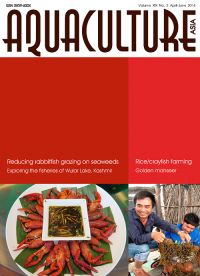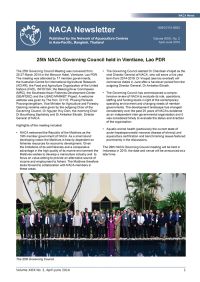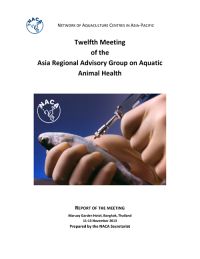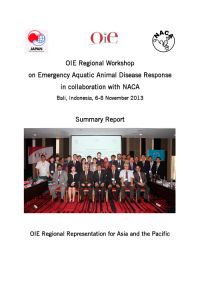In this issue:
Integrated rice/crayfish farming in Hubei Province, China. Improvement of seaweed Kappaphycus alvarezii culture production by reducing grazing by rabbit fish (Siganus spp.). Exploring the fisheries of Wular Lake, Kashmir, India. Golden mahseer Tor putitora - a possible candidate species for hill aquaculture. Free primers for specific detection of bacterial isolates that cause acute hepatopancreatic necrosis disease. Special session on regional cooperation for improved biosecurity. AHPND detection discussion group established.
In this issue:
25th NACA Governing Council held in Vientiane, Lao PDR. Dr Cherdsak Viripat elected as next Director General of NACA. 9th Symposium on Diseases in Asian Aquaculture 24-28 November 2014, Vietnam. NACA to convene the 11th AFS Asian Fisheries and Aquaculture Forum. Free primers for specific detection of bacterial isolates that cause acute hepatopancreatic necrosis disease. World Aquaculture Adelaide 2014: Special session on regional cooperation for improved biosecurity. AHPND detection discussion group established. OIE Regional Workshop on Emerging Aquatic Animal Disease Response, in collaboration with NACA, Bali, Indonesia. United Kingdom - Southeast Asia Workshop on Sustainable Aquaculture.
The Asia Regional Advisory Group on Aquatic Animal Health meets annually to discuss regional health issues including emerging disease threats. This report includes a review of regional disease status circa 2013, global and regional disease reporting arrangements, global issues and standards, progress in implementation of the the Regional Technical Guidelines on Health management for the Responsible Movement of Live Aquatic Animals, identification and designation of regional aquatic animal health resources and regional and international cooperation.
The workshop was held in Bali, Indonesia from 6 to 8 November 2013. The programme included reports on current aquatic animal disease situations in selected countries and presentations on the national aquatic animal health programmes of China, Japan and Korea. In addition, case studies on the molluscan diseases, shrimp diseases and finfish diseases were presented to facilitate the subsequent discussion on emergency response of those diseases in the national and regional level.
The OIE has been working to improve aquatic animal health globally through various activities including the development of Aquatic Animal Health Code and Manual of Diagnostic Tests for Aquatic Animals. Considering that aquaculture is expanding and becoming a major food producing sector in the region of Asia and the Pacific, recent spread and outbreaks of some aquatic animal diseases in the region is our concern.



